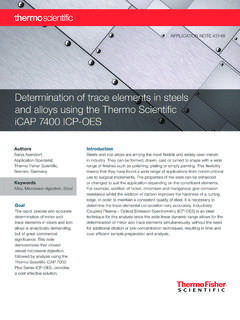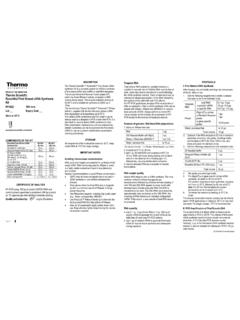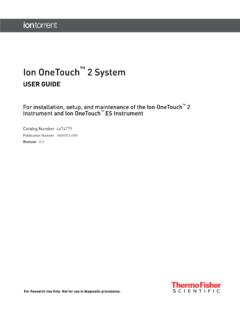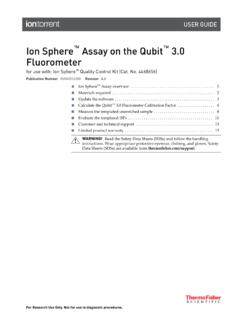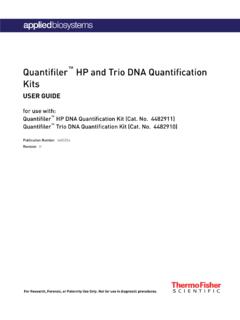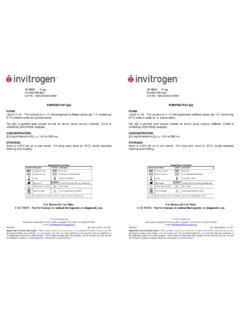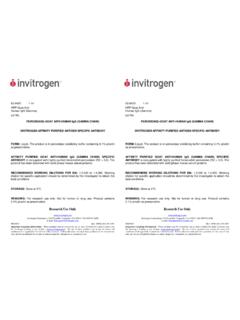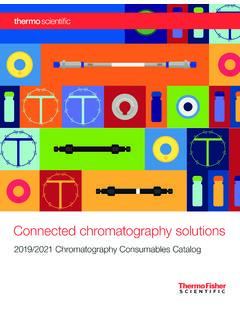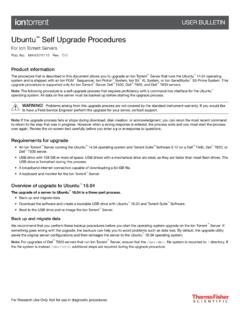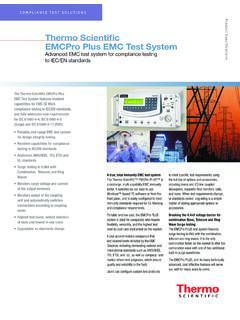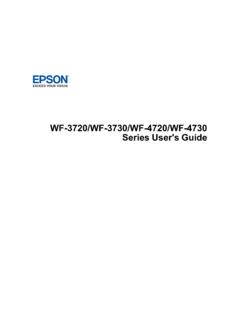Transcription of Thermo Xcalibur Qual Browser
1 Thermo Xcalibur qual Browser User Guide Software Version XCALI-97617 Revision A August 2014. 2014 Thermo Fisher Scientific Inc. All rights reserved. Accela, Xcalibur , and Q Exactive are registered trademarks of Thermo Fisher Scientific Inc. in the United States. Microsoft, Windows, and Excel are registered trademarks of Microsoft Corporation in the United States and other countries. Adobe, Acrobat, and Reader are registered trademarks of Adobe Systems Incorporated in the United States and other countries. All other trademarks are the property of Thermo Fisher Scientific Inc. and its subsidiaries. Thermo Fisher Scientific Inc. provides this document to its customers with a product purchase to use in the product operation. This document is copyright protected and any reproduction of the whole or any part of this document is strictly prohibited, except with the written authorization of Thermo Fisher Scientific Inc.
2 The contents of this document are subject to change without notice. All technical information in this document is for reference purposes only. System configurations and specifications in this document supersede all previous information received by the purchaser. This document is not part of any sales contract between Thermo Fisher Scientific Inc. and a purchaser. This document shall in no way govern or modify any Terms and Conditions of Sale, which Terms and Conditions of Sale shall govern all conflicting information between the two documents. Release history: Revision A, August 2014. Software version: Xcalibur and later For Research Use Only. Not for use in diagnostic procedures. C. Contents Preface .. ix About This Guide..ix Related Documentation .. x Safety and Special Notices ..xi Contacting Us.
3 Xii Chapter 1 Introduction ..1. Understanding Mass Spectra .. 1. Base Peak.. 2. Neutral Losses .. 2. Effect of Ionization Modes .. 3. Adduct Formation .. 5. Effect of Isotopes .. 5. Analysis Modes for the Mass Spectrometer .. 6. Full Scan .. 6. Selected Ion Monitoring (SIM) .. 7. MS/MS .. 7. Chapter 2 Using the qual Browser Window ..9. Opening the qual Browser Window .. 10. Using the qual Browser Toolbars .. 11. Displaying Toolbars .. 12. Customizing the Toolbar.. 13. Using the Info Bar.. 16. Working with Windows .. 17. Identifying Inactive, Active, and Pinned Cells .. 18. Changing the Cell State.. 19. Using the Cursor .. 20. Viewing Data Files in qual Browser .. 21. Opening Single Raw Files in qual Browser .. 22. Opening a Sequence Set of Raw Data Files in qual Browser .. 23. Opening and Viewing Result Files in qual Browser .
4 26. Thermo Scientific Xcalibur qual Browser User Guide iii Contents Working with Cells .. 29. Making a View Active .. 29. Inserting and Deleting Cells .. 31. Adjusting the Cell Size.. 32. Amplifying Regions of a Plot .. 34. Adding Text to a Plot .. 35. Adding Graphics to a Plot .. 37. Removing Text and Graphics from a Plot .. 39. Opening or Changing Views in Cells.. 40. Scaling a Plot.. 42. Managing Layouts .. 43. Creating and Saving a Layout .. 43. Opening and Applying a Layout .. 44. Displaying Layout Summary Information .. 45. Using the Cell Information Page .. 46. Chromatogram Information .. 47. Spectrum Information .. 48. Setting the Global Mass Options for the qual Browser Window.. 48. Chapter 3 Using Views Interactively ..51. Selecting a Point on a Plot.. 52. Selecting a Point on a Plot: Example 1.
5 54. Selecting a Point on a Plot: Example 2 .. 55. Selecting a Point on a Plot: Example 3 .. 55. Selecting a One-Dimensional Range on a Plot.. 56. Selecting a One-Dimensional Range: Example 1 .. 58. Selecting a One-Dimensional Range: Example 2 .. 59. Selecting a Two-Dimensional Range on a Plot .. 60. Using Scan Filters .. 62. Scan Filter Format.. 64. Applying a Scan Filter to a Plot .. 67. Displaying Multiple Magnifications of a Plot .. 69. Chapter 4 Working with a Chromatogram View ..73. Inserting and Deleting Chromatogram Plots .. 74. Setting the Chromatogram Ranges and Processing Options .. 74. Setting Chromatogram Ranges .. 74. Setting Automatic Processing for Chromatograms.. 77. Adding Plots to a Chromatogram View with the Autofilter Command .. 81. iv Xcalibur qual Browser User Guide Thermo Scientific Contents Setting the Chromatogram Display Options.
6 82. Setting the Chromatogram Axis Options.. 82. Setting the Chromatogram Color Options .. 84. Setting the Chromatogram Label Options .. 85. Setting the Chromatogram Normalization Options.. 86. Setting the Chromatogram Style Options .. 88. Detecting Peaks .. 89. Automatic Detection of One Plot .. 90. Automatic Detection of All Plots.. 90. Manual Detection .. 90. Reviewing the Effect of Different Peak Detection Settings .. 92. Chapter 5 Working with a Spectrum View ..95. Setting Spectrum Display Options .. 95. Setting the Spectrum Axis Options .. 96. Setting the Spectrum Color Options .. 97. Setting the Spectrum Label Options .. 98. Setting the Spectrum Normalization Options .. 100. Setting the Spectrum Style Options.. 101. Setting the Spectrum Composition Options .. 103. Setting Spectrum List Display Options.
7 104. Setting the Spectrum List Normalization Options .. 104. Setting the Spectrum List Style Options .. 106. Setting the Spectrum List Composition Options .. 107. Setting Spectrum Ranges and Processing Options .. 109. Setting Spectrum Ranges .. 109. Setting Automatic Processing for Mass Spectra .. 111. Subtracting Background Spectra .. 113. Chapter 6 Working with a Map View ..115. Setting Map Ranges.. 116. Setting Map Display Options .. 117. Setting the Map Style Options .. 118. Setting the Map Axis Options .. 119. Setting the Map Color Options .. 120. Setting the Map Normalization Options .. 121. Setting the Band Width .. 123. Thermo Scientific Xcalibur qual Browser User Guide v Contents Appendix A qual Browser Window..125. qual Browser Menus.. 126. Actions Menu qual Browser .. 126. Display Menu qual Browser .
8 130. Edit Menu qual Browser .. 133. File Menu qual Browser .. 134. Grid Menu qual Browser .. 136. Help Menu qual Browser .. 139. Tools Menu qual Browser .. 139. View Menu qual Browser .. 140. Window Menu qual Browser .. 142. qual Browser Toolbars .. 143. Amplify Toolbar qual Browser .. 143. Main Toolbar qual Browser .. 144. qual Browser Views .. 153. Chromatogram View .. 155. Error Log View .. 159. Instrument Method View .. 159. Ion Map View .. 162. Map View .. 168. Sample Information View .. 169. Scan Filter View .. 171. Scan Header View .. 172. Spectrum List View .. 174. Spectrum View .. 177. Status Log View.. 180. Tune Method View .. 183. qual Browser Info Bar.. 184. Cell Information Page .. 185. Elemental Composition Page.. 187. MSn Browser Information Page .. 191. Avalon Peak Detection Settings Page.
9 196. ICIS Peak Detection Settings Page .. 200. Genesis Peak Detection Settings Page .. 203. Result File Information Page .. 207. Sequence Information Page .. 208. Spectrum Simulation Page .. 209. vi Xcalibur qual Browser User Guide Thermo Scientific Contents qual Browser Dialog Boxes .. 217. Add Graphics Dialog Box .. 218. Add Text Dialog Box.. 221. Amplify by Other Factor Dialog Box .. 229. Average Filter Selection Dialog Box.. 230. Cell Size Dialog Box .. 231. Choose Centroiding Algorithm Dialog Box.. 232. Color Dialog Box .. 234. Copy to Clipboard Dialog Box .. 235. Display Options Dialog Box in qual Browser .. 236. Global Mass Options Dialog Box .. 273. Heading Editor Dialog Box .. 274. Peak Purity Dialog Box .. 279. Print Dialog Box .. 281. Ranges Dialog Boxes .. 282. Search Properties Dialog Box.
10 311. Select Isotopes Dialog Box.. 315. Specify Mixture for Simulation Dialog Box .. 317. Toolbars Dialog Box .. 318. Subtract Background Window .. 319. qual Browser Result File Window .. 322. Index ..323. Thermo Scientific Xcalibur qual Browser User Guide vii P. Preface This user guide for qualitative analysis describes how to use the Thermo Xcalibur mass spectrometry data system to identify unknown compounds or carry out a trace analysis. Before reading this manual, read the Getting Started manual for the Xcalibur data system and the getting started manual for your Thermo Scientific mass spectrometer so that you are familiar with the basic features of the Xcalibur data system, such as the Home Page and the Instrument Setup view. Contents About This Guide Related Documentation Safety and Special Notices Contacting Us To provide us with comments about this document, click the link below.
